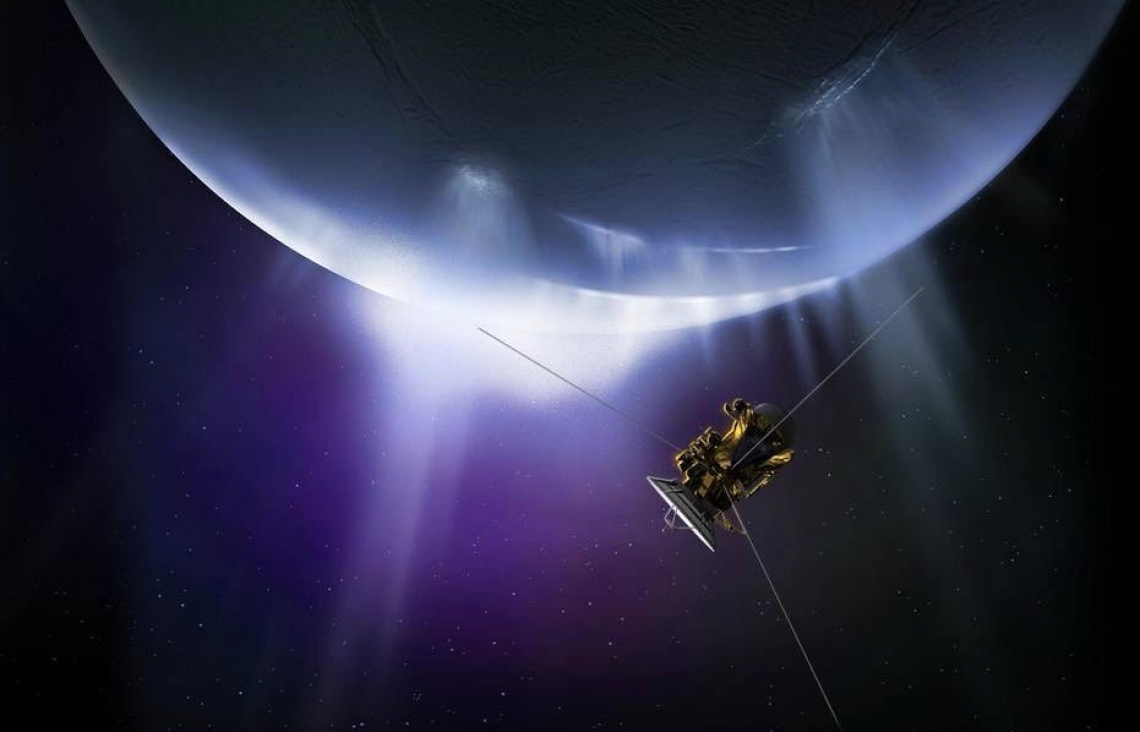How life could be detected on Enceladus
The mystery of whether microbial alien life exists on Enceladus could be solved by a spacecraft orbiting Saturn’s moon, according to a new study led by University of Arizona researchers. In a paper published in The Planetary Science Journal, the researchers show how a hypothetical space mission could provide definitive answers.
When Enceladus was first surveyed by NASA’s Voyager 1 spacecraft in 1980, it looked like a small, unexciting “snowball” in the sky. Later, between 2005 and 2017, NASA’s Cassini spacecraft orbited the Saturn system, examining Saturn’s complex rings and moons in unprecedented detail. Scientists were stunned when Cassini discovered that Enceladus’ thick layer of ice hides a vast, warm saltwater ocean from which methane is off-gassing, a gas that normally comes from microbial life on Earth.
The methane and other organic molecules that form the basis of life were discovered when Cassini flew through huge plumes of water emanating from Enceladus’ surface. As the tiny moon orbits the ringed gas giant, it is squeezed and tugged by Saturn’s massive gravitational field, causing its interior to heat up from friction. As a result, spectacular plumes of water shoot into space from cracks and fissures on Enceladus’ icy surface.
Last year, a team of scientists from UArizona and Université Paris Sciences et Lettres calculated that if life has arisen on Enceladus, it likely represents the reason the moon is ejecting methane. “To find out if this is the case, we need to go back to Enceladus and see,” said Régis Ferrière, lead author of the new study and an associate professor in UArizona’s Department of Ecology and Evolutionary Biology.
In their latest work, Ferrière and his collaborators report that while the hypothetical total mass of living microbes in Enceladus’ ocean would be small, a visit from an orbiting spacecraft would be enough to determine with certainty whether Enceladus’ ocean beneath its shell is populated by microbes. The excess methane Cassini detected in the exhaust is reminiscent of extraordinary ecosystems found in the lightless depths of Earth’s oceans: hydrothermal vents. Here, at the edges of two adjacent tectonic plates, hot magma beneath the seafloor heats seawater in the porous bedrock, creating “white smokers,” vents that spew out glowing hot, mineral-saturated seawater. With no access to sunlight, the organisms rely on energy stored in chemical compounds released by the white smokers.
“On our planet, hydrothermal vents are teeming with creatures large and small, despite the darkness and insane pressure,” Ferrière said. “The simplest creatures there are microbes called methanogens, which provide energy even without sunlight.” Methanogens convert dihydrogen and carbon dioxide to produce energy, releasing methane as a byproduct. Ferrière’s research group based their calculations on the hypothesis that there are methanogens on Enceladus that inhabit oceanic hydrothermal vents similar to those on Earth. In this way, the researchers calculated the total mass of methanogens on Enceladus and the likelihood that their cells and other organic molecules could be ejected by the plumes.
“We were surprised to find that the hypothetical amount of cells would only be equivalent to the biomass of a single whale in Enceladus’ global ocean,” said the study’s lead author, Antonin Affholder, a postdoctoral researcher at UArizona. “The biosphere of Enceladus could be very sparse. However, our models suggest that it would be productive enough to provide the plumes with just enough organic molecules or cells to be detected by instruments aboard a future spacecraft. But such a mission would require an orbiter to fly through the plume several times to collect as much oceanic material as possible.” About 100 flythroughs would meet the requirement.
The paper makes recommendations about the minimum amount of material that must be collected from plumes to search with confidence for both microbial cells and specific organic molecules. Cells found would represent direct evidence of life. “However, the likelihood of actually finding cells is likely to be low,” Affholder said, “because they would have to survive the outgassing process that transports them through the plumes from deep ocean to the vacuum of space – quite a long journey for a tiny cell.” Instead, the authors suggest that discovered organic molecules, such as certain amino acids, could serve as indirect evidence for or against a life-rich environment. “Considering that, according to our calculations, any life on Enceladus would be extremely sparse, there is some risk that we will never find enough organic molecules in the exhaust to conclusively infer life,” Ferrière said. “So rather than focusing on how much is enough to prove there is life, we asked, ‘What is the maximum amount of organic material that could be present if there is no life?'”
